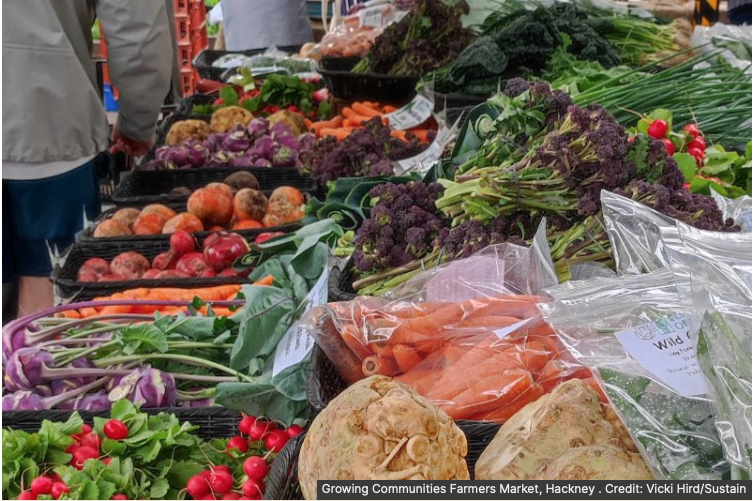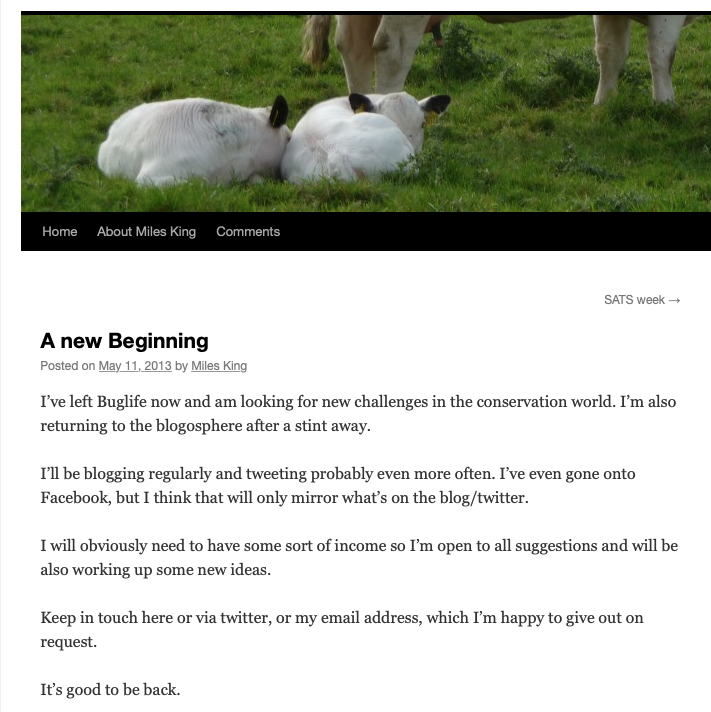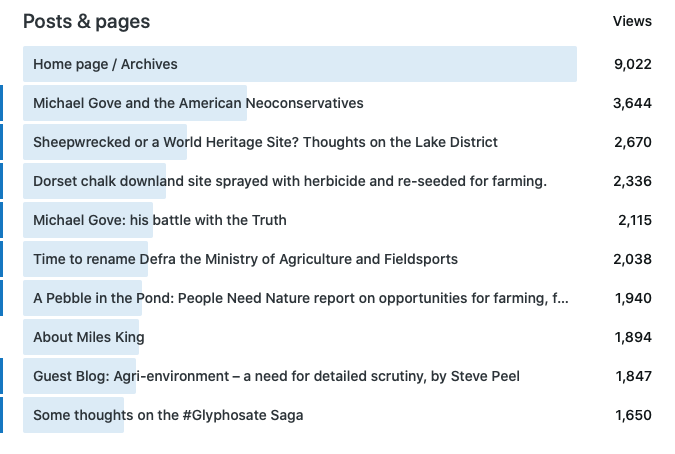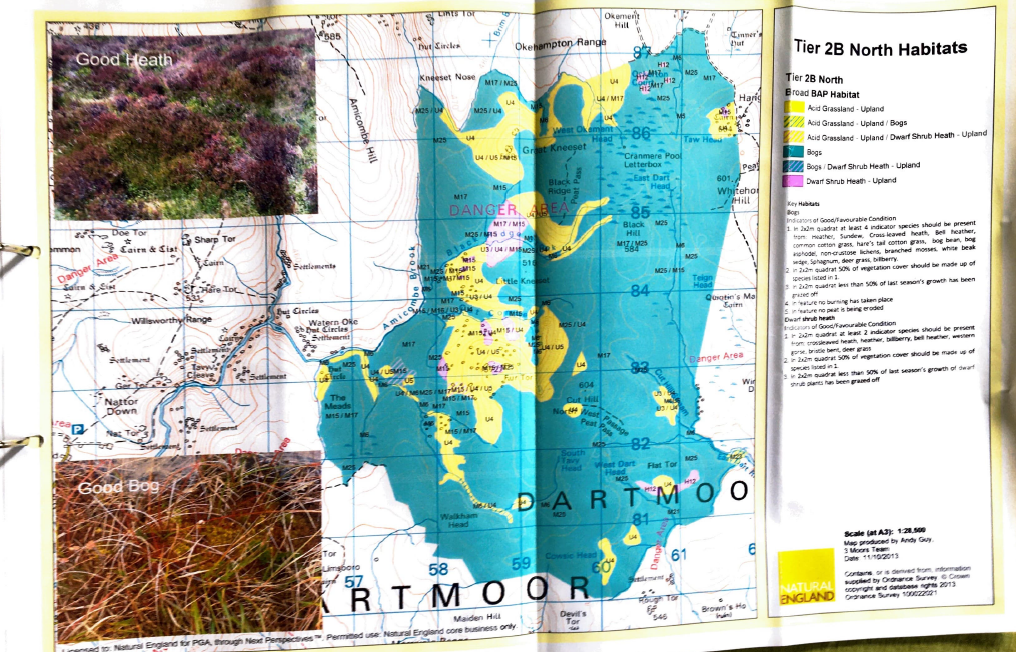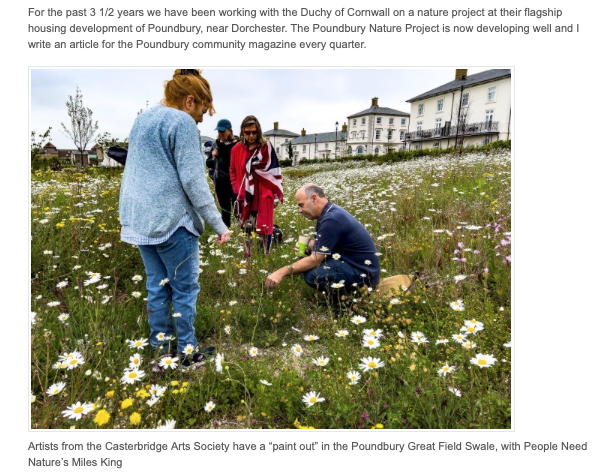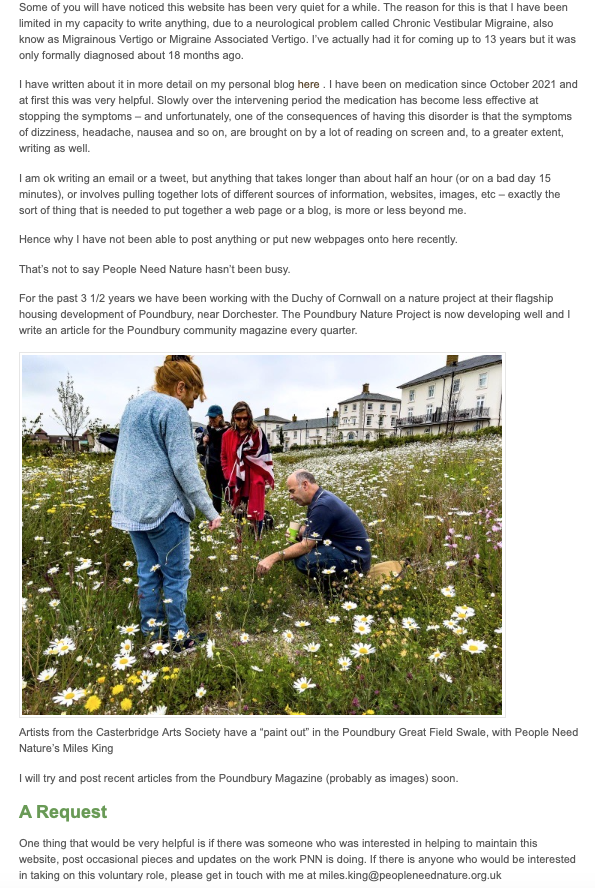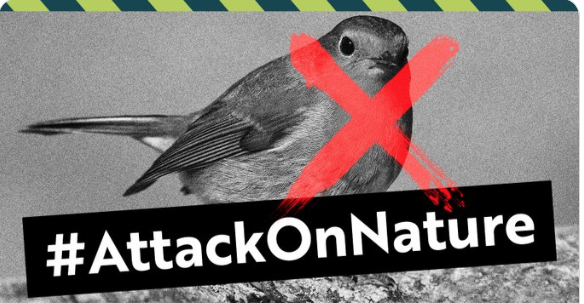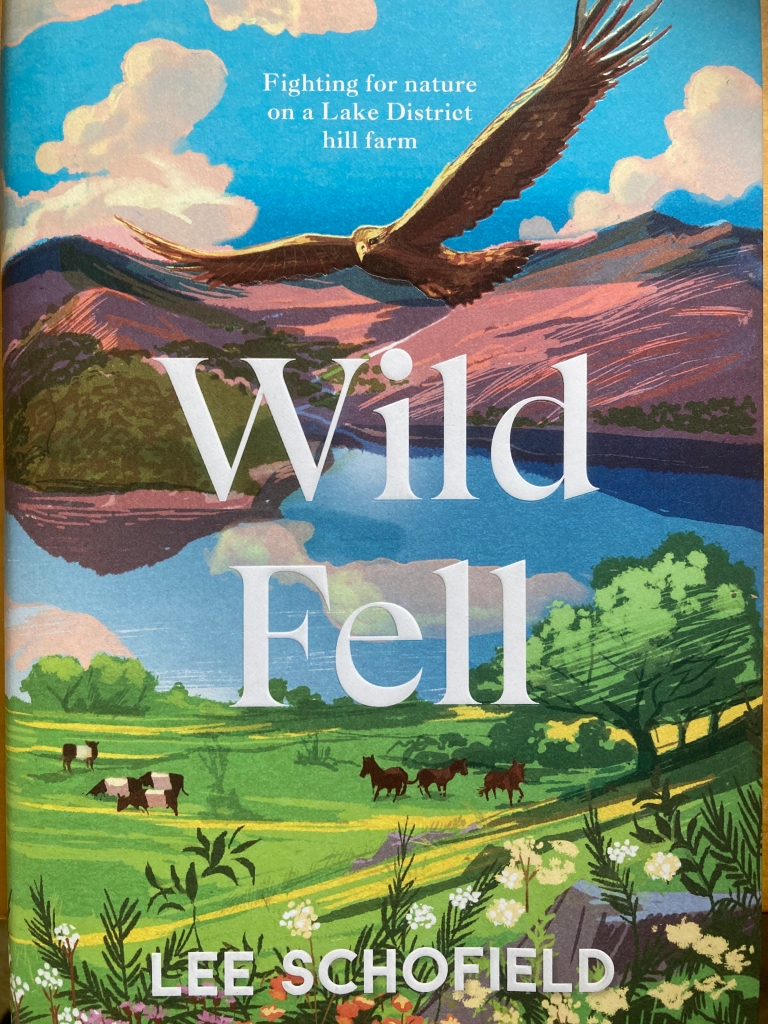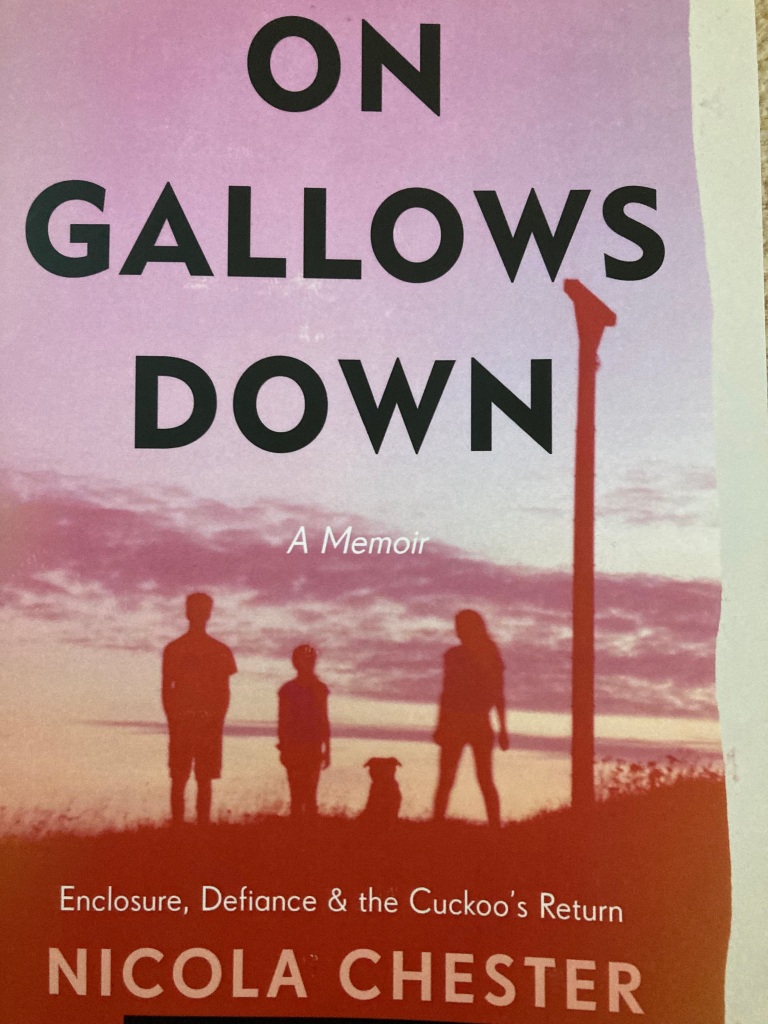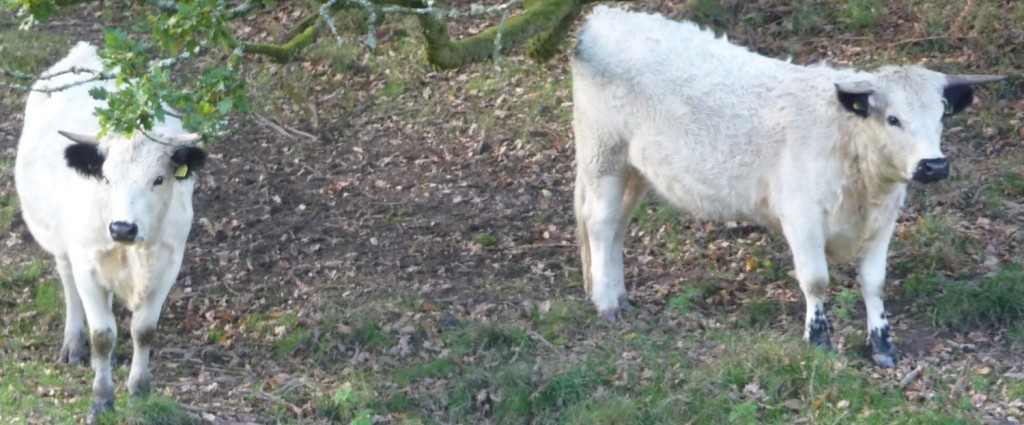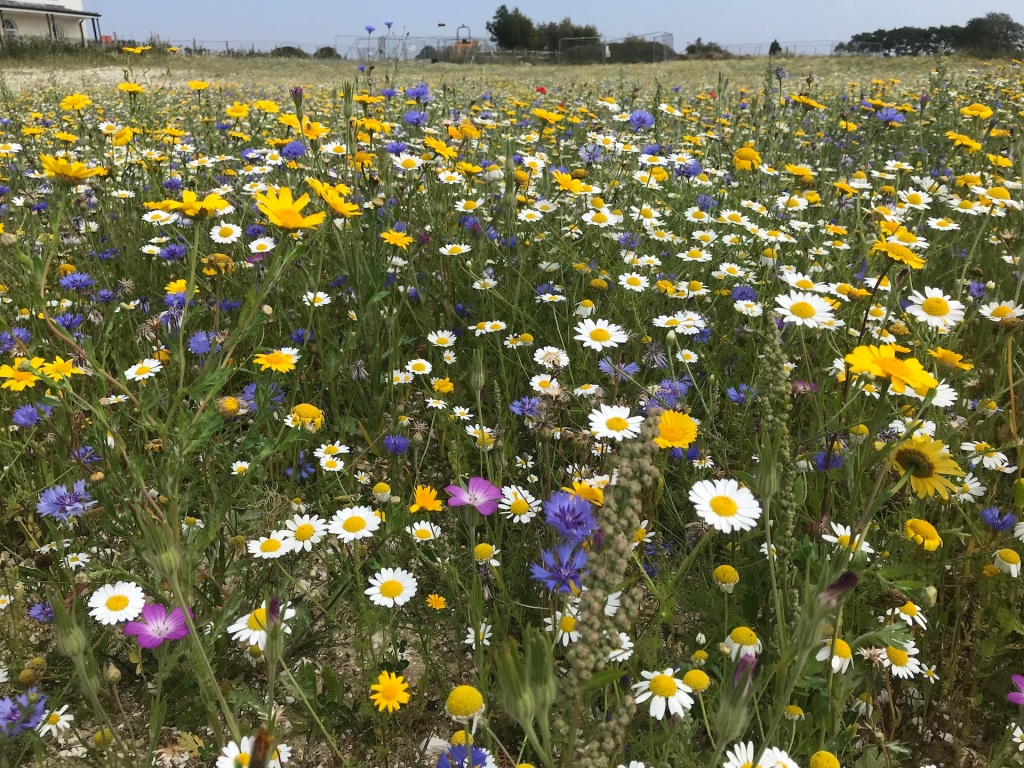
I normally keep my job and this blog separate but it’s one of those moments when I think it’s worth making that crossover.
I set up People Need Nature in 2015 with a couple of friends, having become somewhat disillusioned with working in the nature conservation sector. I was interested in how best to promote the sensory, emotional and even spiritual values of nature, rather than taking the scientific approach. It’s fair to say the Summer of 2015 was not the best time to start a new charity, when one looks back over the last 8 years.
One project, that has been successful though is the work I’ve been doing through PNN at Poundbury, Prince Charles’ (as was) new housing development on the outskirts of Dorchester where I live. The Poundbury Nature Project has, ironically, been all about using the skills and experience I’ve developed over the past nearly 40 years (gulp) in nature conservation – creating new places rich in wildlife, for people to find joy, inspiration, peace, awe, solace; and all the other things nature provides us with.
The intention was always to create a new resource of urban places rich in nature, to showcase what can be done in new housing developments, and also to show how they can make a real difference to all people’s lives, in a way where people don’t have to make any effort to travel to see wildlife in distant nature reserves.
The idea of creating a “green social prescribing” project had been in my mind since 2020, when we applied (unsuccessfully) to the Lottery for funding to create one, using the Covid Green Recovery Challenge Fund and working with our friends at The Poetry Society.
Green Social Prescribing is a fairly new concept in the health sector, where people with mental and physical health problems are helped by being in nature, and taking part in various activities in a nature-rich environment. I met a leading Green Social Prescribing expert, Dr Lucy Loveday, at an event at the Woodland Trust’s Fingle Woods in 2021 and this enthused me that we could do something in Poundbury.
A chance discussion before Christmas 2022 led to us receiving a grant for such a project off the ground in Poundbury, but we needed to double that grant from other sources to make it happen. Having watched the “Wild Isles” Attenborough documentary, I noticed that RSPB and WWF had set up a campaign “saving our wild isles”, including the additional non-BBC documentary about conservation, which complemented the main series. Remember there was quite a bit of fuss about this, and whether the BBC had decided to “pull” the conservation documentary.
Well anyway, Aviva, the big insurance/pensions company, had decided to put some money (£1m) into a fund to support conservation projects, and, handily for us, projects that support people getting involved with conservation projects, and actively engaging people in nature projects, for their own health and wellbeing. It had been going for a while before it occurred to me that our Green Social Prescribing project might actually meet their criteria and I applied. I’m still slightly amazed that we were successful, as I have to say my experience of fundraising for People Need Nature has not been dramatically successful, indeed the opposite is usually the case.
Nature for Wellbeing
Our project, Poundbury Nature for Wellbeing is a pilot project. There will be three separate strands within the project. The first one is being in nature, noticing nature and helping nature. This will include gentle nature walks and talks. Sitting and noticing nature. Searching for awe in nature. We also need to manage all of these areas as they are urban grasslands and we can’t graze them. There’s lots of mowing and raking to be done. We’ll also collect wildflower seeds from nearby ancient grasslands, and propagate them or sow them directly to create new areas and enhance existing ones.
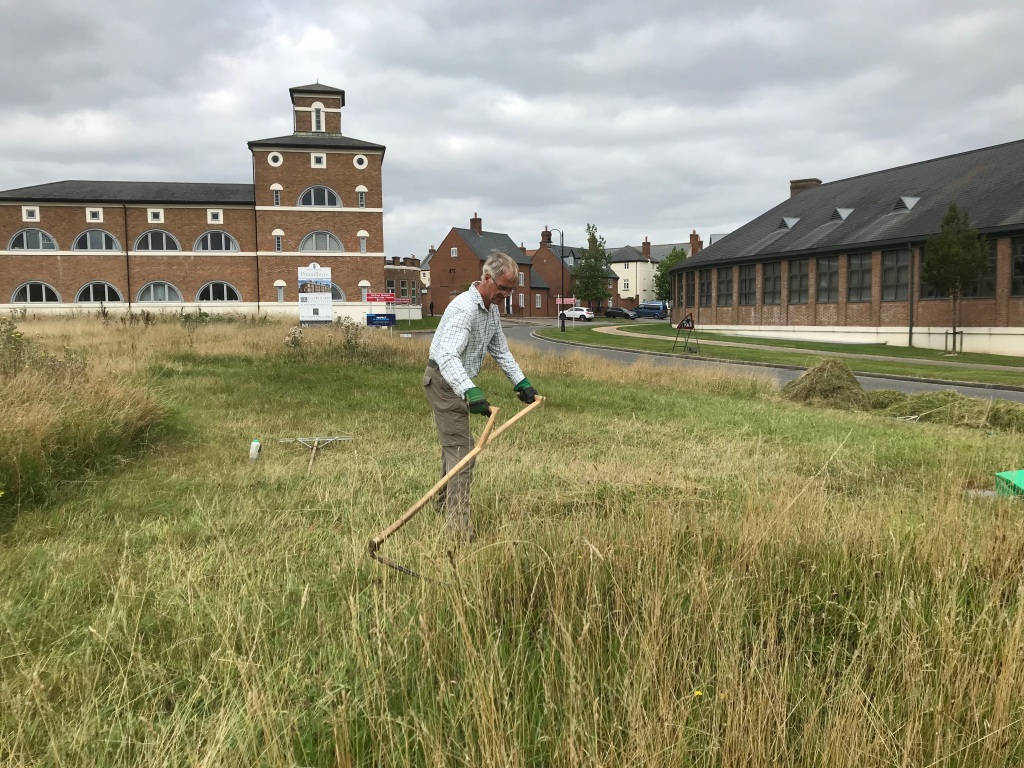
One of the areas we’re creating is a new Wildflower Meadow for the local school, Damers First School. I’ve been working with the school over the past two years, taking the children out of the school to learn about wildlife, collect seeds and grow them on. Now we’re seeding the new meadow area with wildflowers the children have collected. Then the meadow will be a fantastic resource for the children to use in their normal every day learning.
The other thing we’ll be doing is some citizen science – Butterfly and Bee walks, counting Bee Orchids and measuring other things to gather evidence for how our management is changing these places and whether we need to tweak it. There’s good evidence people taking part in Citizen Science improve their mental health and wellbeing.
The second strand is Arts and Nature. Practitioners will lead activities for the participants using poetry, singing, storytelling. creative writing and painting, to help them engage more deeply with nature. They’ll be immersed in the wildflower meadows and chalk downland (not a million miles from forest bathing) and hopefully inspired by nature to let their creative juices flow.
Thirdly we’ll organise gentle exercise (Tai Chi, yoga) meditation, visualisation and learning breathing techniques, again within nature. There is already a free Yoga in the Park project running in Dorchester and we’ll aim to complement already existing activities.
The plan is that people struggling with their mental health will be referred from their GPs, via local social prescribing link officers, to take part in activities of their choice, free to them. Indeed we’re mindful of the need to find funds to support travel costs for those participants who cannot afford it. We’ll offer taster events and if participants want to continue with that particular activity they can join a further two or three sessions.
Aviva Saving our Wild Isles Crowdfunder
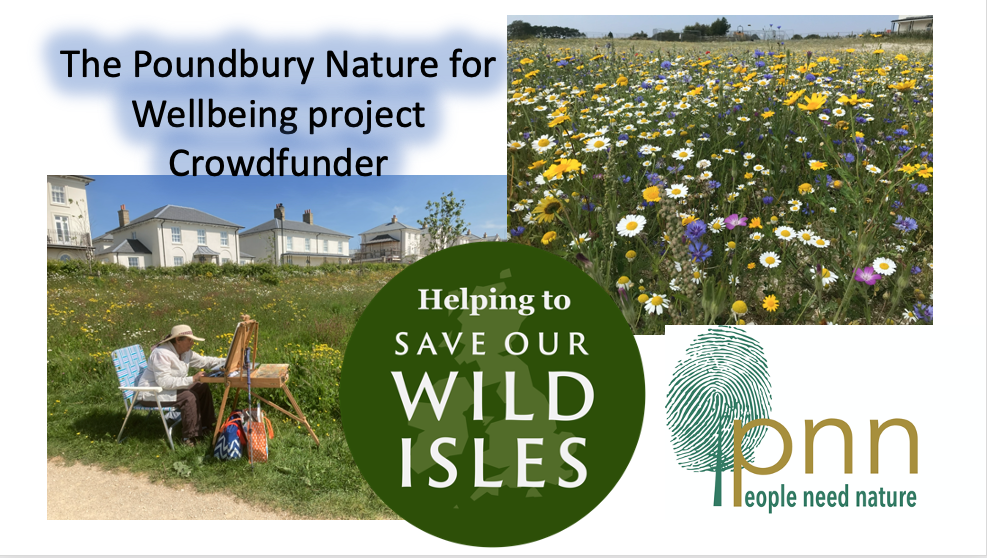
As I mentioned, we’ve been successful in our bid to be one of the projects benefitting from the Saving Our Wild Isles Aviva community fund. This is being run through online fundraising platform Crowdfunder. We’re hoping to raise £3000 and the Crowdfunder launched last Friday, so we have about six weeks to raise as much as we can.
For every pound we raise from donors, Aviva will add £2 to triple the original donation. Donations up to £250 will be tripled with a £500 donation from Aviva. After that any larger donations will still receive £500 from Aviva. It’s a very generous arrangement.
Here is the link to our Crowdfunder page, where you’ll find a video and more information about the project.
So far we’ve raised £660 in the first three days which is amazing and thank you to everyone who has donated generously so far. Even just a £5 donation (not much more than the price of a coffee) will be tripled to £15 by Aviva so no amount is too small to give.
There are also rewards to claim, including signed copies of Guy Shrubsole’s Lost Rainforests of Great Britain; PNN Trustee Lisa Schneidau’s Botanical Folk Tales, Woodland Folk Tales and River Folktales of Britain and Ireland; and for those local to the area I am offering free guided walks around Poundbury and further afield to some fabulous sites rich in history and wildlife.
You can read more about the evolution of the Poundbury Nature Project in articles I have written for the Poundbury Magazine, which I have recently uploaded onto the PNN website.

